Crafting a compelling electrician cover letter is crucial for landing your dream job. A well-written cover letter serves as your first impression, allowing you to showcase your skills, experience, and qualifications to potential employers. This guide provides electrician cover letter samples that work, along with essential tips to help you create a standout application that grabs attention and increases your chances of getting hired. We will explore different examples tailored to varying experience levels, ensuring you have the tools necessary to make a lasting impression.
What Makes an Electrician Cover Letter Effective
An effective electrician cover letter goes beyond simply listing your qualifications. It should highlight your key skills, demonstrate your relevant experience, and showcase your personality and enthusiasm for the role. It’s about making a strong case for why you are the perfect fit for the job and the company. Your cover letter needs to be tailored to each specific job application, referencing the specific requirements and responsibilities outlined in the job description. A generic cover letter won’t cut it; you must demonstrate that you have taken the time to understand the position and the employer’s needs.
Highlighting Your Electrician Skills
Your cover letter is the ideal place to showcase your core electrician skills. Don’t just list these skills; provide specific examples of how you have utilized them in past roles. Employers want to see that you have the practical abilities required to perform the job effectively. Make sure you quantify your achievements whenever possible, using numbers to demonstrate the impact of your work. Be specific and provide concrete examples to back up your claims. This is your chance to prove that you possess the necessary skills to excel in the role.
Technical Proficiency
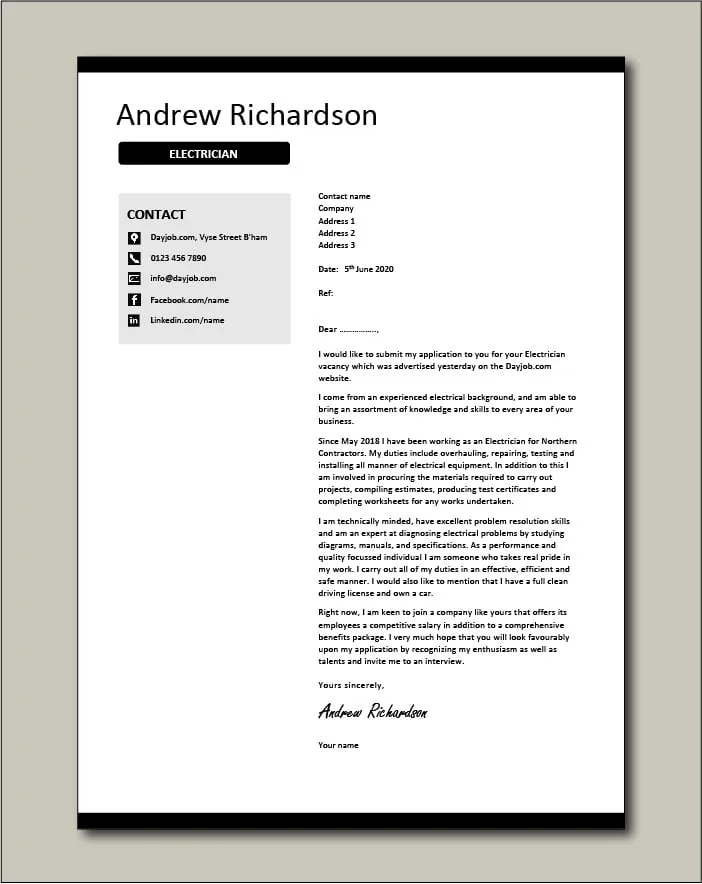
Detail your experience with various electrical systems, wiring methods, and equipment. Mention any specialized knowledge, such as experience with industrial, commercial, or residential electrical systems. Highlight your ability to read and interpret blueprints, schematics, and technical manuals accurately. Proficiency in using electrical testing equipment, such as multimeters, oscilloscopes, and wire tracers, should be emphasized. Provide examples where you’ve used these skills to troubleshoot, diagnose, and repair electrical issues effectively.
Problem-Solving Abilities
Electricians frequently encounter complex electrical problems that require critical thinking and effective problem-solving skills. Illustrate your ability to analyze situations, identify root causes, and implement effective solutions. Provide examples where you have successfully resolved challenging electrical issues, describing the steps you took and the positive outcomes achieved. Demonstrate your ability to think on your feet, adapt to changing circumstances, and find innovative solutions to complex problems. This shows your resourcefulness and ability to handle unexpected situations.
Safety Consciousness
Safety is paramount in the electrical trade. Emphasize your commitment to safety protocols, including the use of personal protective equipment (PPE) and adherence to safety regulations. Mention any safety certifications you hold, such as OSHA certifications. Highlight your experience following safety procedures, identifying potential hazards, and implementing safety measures. Show your understanding of electrical safety standards and your dedication to maintaining a safe work environment. Emphasizing safety demonstrates your professionalism and consideration for the well-being of yourself and others.
Showcasing Your Experience

Provide a concise overview of your work history, including previous employers, job titles, and the duration of your employment. Focus on the most relevant experience for the specific job you are applying for. Highlight your accomplishments and responsibilities in each role, using action verbs to describe your contributions. Tailor your descriptions to the requirements of the job description, ensuring you emphasize skills and experiences that align with the employer’s needs. Use this section to demonstrate the breadth and depth of your experience in the field of electrical work.
Previous Work History
When detailing your previous work history, provide the name of the company, your job title, and the dates of your employment. Briefly describe your responsibilities and achievements in each role. Focus on quantifying your achievements whenever possible, using metrics such as projects completed, budgets managed, or efficiency improvements. Use action verbs to start each bullet point, such as “installed,” “maintained,” “troubleshot,” or “managed.” Show a clear progression of your career, highlighting the growth of your skills and responsibilities over time.
Project Examples
Include specific examples of projects you have worked on, highlighting your role and contributions. Describe the scope of the project, your responsibilities, and the outcomes achieved. Use these examples to demonstrate your skills in different areas of electrical work, such as installation, maintenance, or repair. Quantify your accomplishments, such as the number of circuits installed or the reduction in downtime achieved through your maintenance efforts. This shows your ability to apply your skills in a practical setting. (Image: Electrician working on a project)
Certifications and Licenses
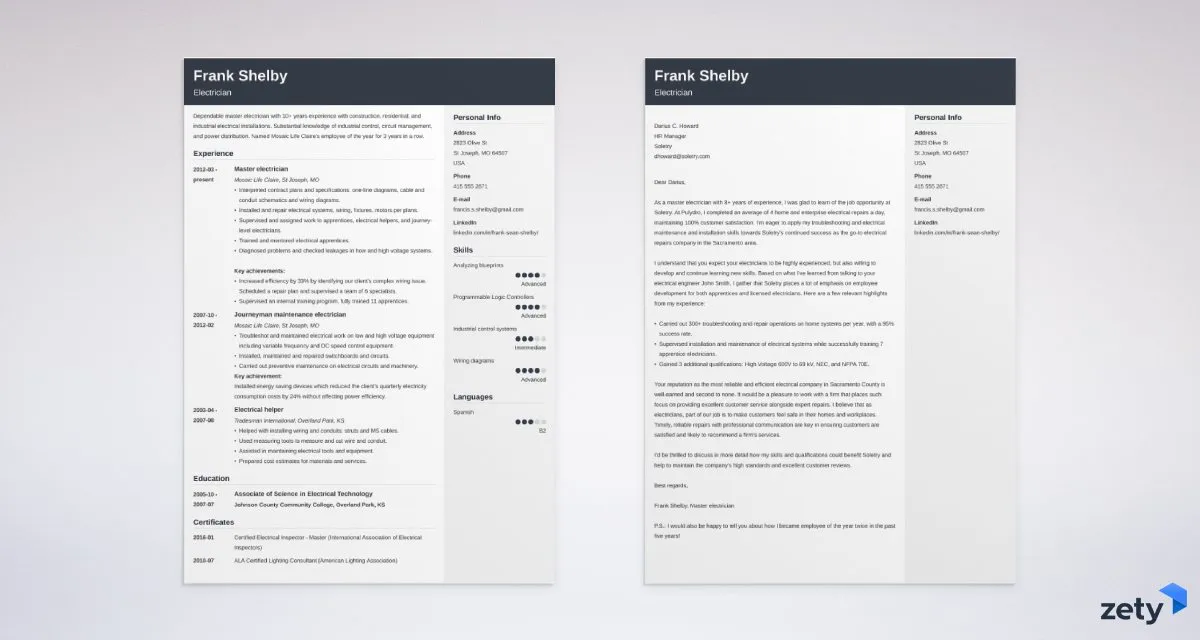
List all relevant certifications and licenses, including their names, issuing organizations, and dates of issue. Make sure your licenses are current and valid, as this is a basic requirement for most electrician positions. Mention any specialized certifications, such as those related to specific types of equipment or systems. Include the license number if the employer requests it. Be sure to showcase any continuing education or professional development courses to demonstrate your commitment to staying up-to-date with industry standards.
Relevant Certifications
Include details of your certifications, such as OSHA certifications, Master Electrician certifications, or any specialized certifications relevant to the job. Specify the certification name, the issuing organization, and the date of issue. Highlight certifications that are directly relevant to the requirements outlined in the job description. Certifications prove that you meet the required standards of the profession and show your expertise in the field. This reinforces your professionalism and commitment to safety and quality.
License Details
Provide your license number, the state in which you are licensed, and the license type. This ensures that employers can verify your credentials and confirm that you are authorized to perform electrical work. Make sure your license is valid and current. Include any endorsements or specializations listed on your license. It’s important to provide clear, accurate, and verifiable information to maintain transparency and build trust with the prospective employer. This step also confirms that you meet the legal requirements for practicing your trade.
Formatting Your Electrician Cover Letter
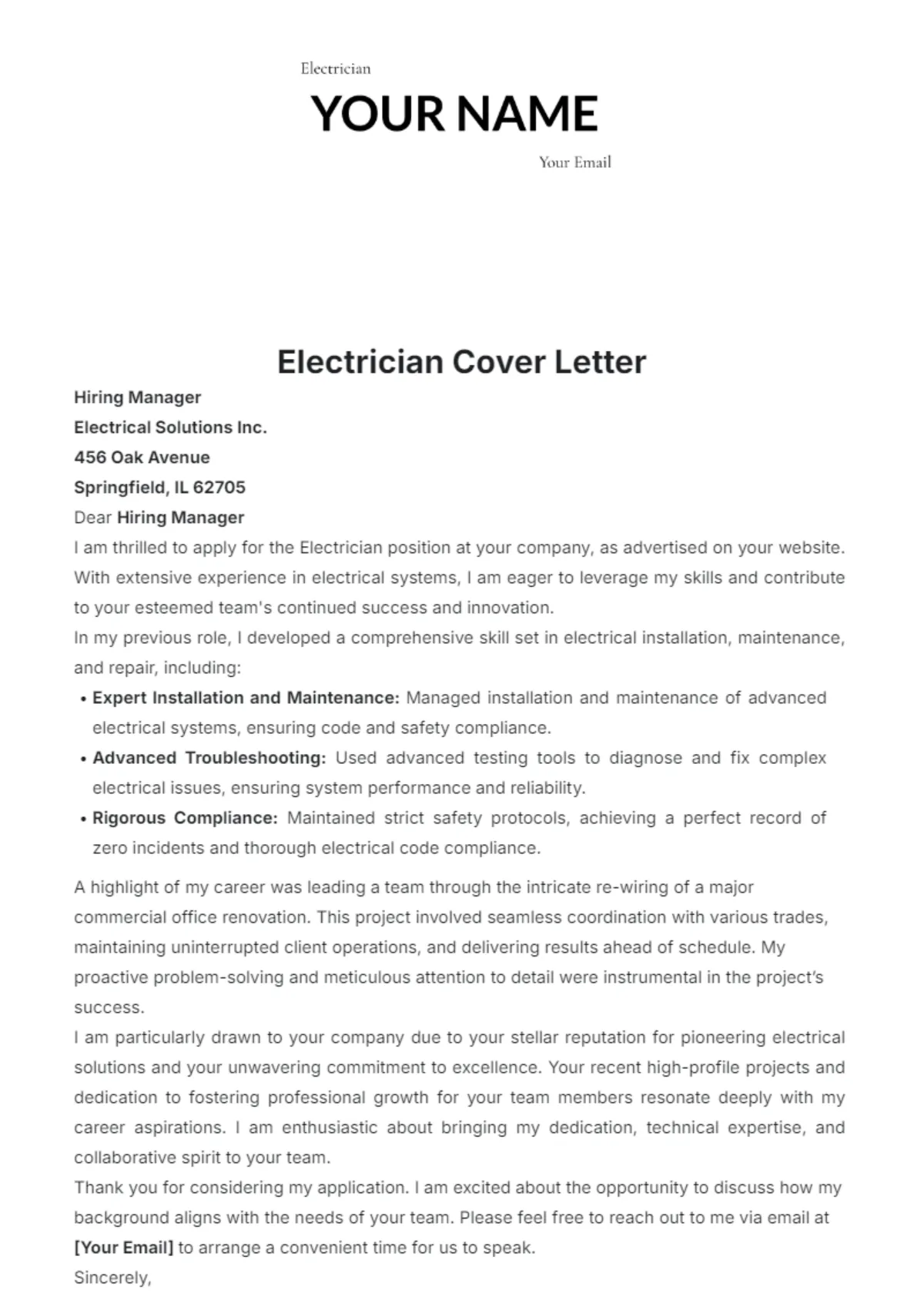
A well-formatted cover letter is easy to read and visually appealing. Use a professional font, such as Arial or Times New Roman, and maintain a consistent font size throughout the document. Use clear headings and subheadings to break up the text and make it easy to scan. Keep the paragraphs concise and to the point, avoiding long blocks of text. Proper formatting is just as important as content; a well-structured cover letter shows attention to detail and professionalism, and demonstrates your organizational skills.
Contact Information
At the top of your cover letter, include your full name, phone number, email address, and mailing address. Ensure your contact information is accurate and up-to-date. Use a professional-sounding email address. It’s important to make it easy for employers to contact you. Check your voicemail greeting to ensure it sounds professional and that your mailbox is not full. This is an important initial step. (Image: A business card with contact information)
Formatting the Body
The body of your cover letter should be well-structured and easy to follow. Start with a professional salutation, such as “Dear [Hiring Manager Name],” or “Dear [Company Name] Hiring Team.” In the first paragraph, state the position you are applying for and how you learned about the opportunity. In the subsequent paragraphs, highlight your skills and experience, providing specific examples. Use action verbs, and quantify your achievements whenever possible. Conclude the letter with a call to action. Maintain a professional and respectful tone throughout.
Closing the Letter
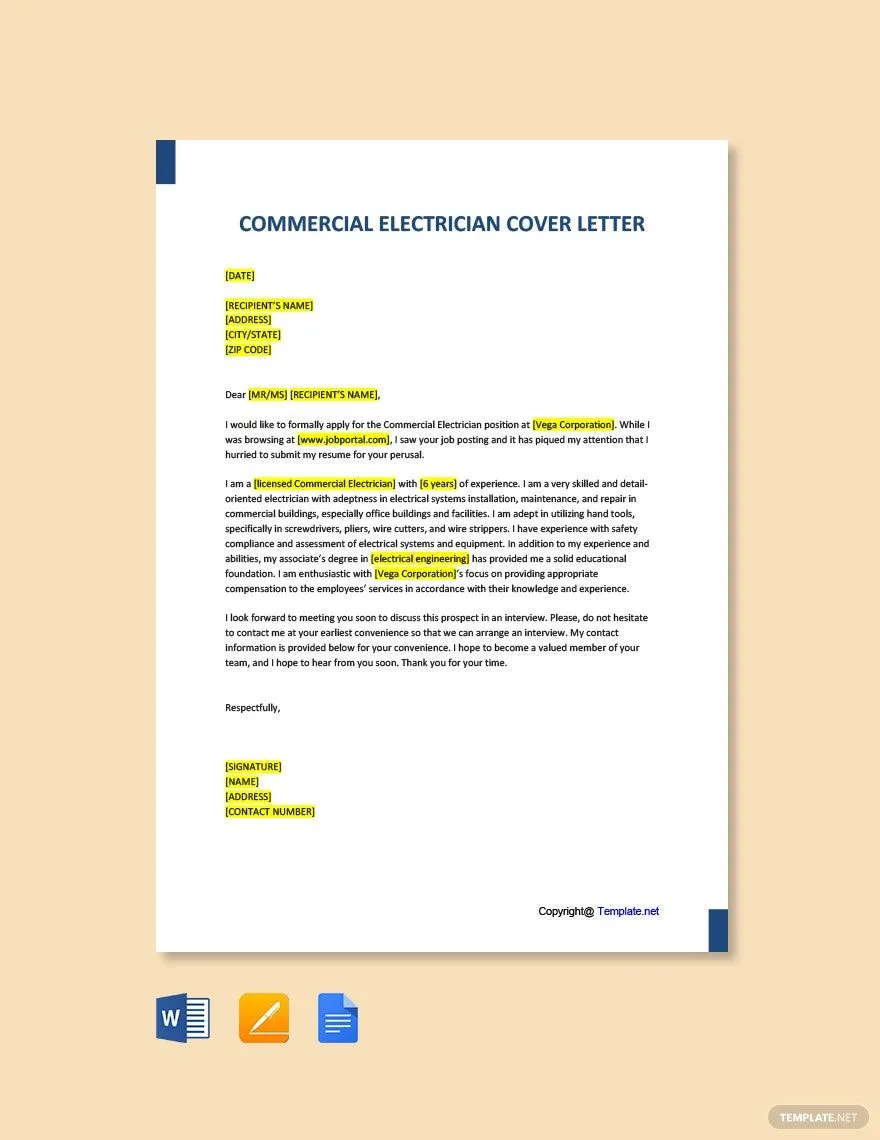
End your cover letter with a professional closing, such as “Sincerely,” or “Best regards,” followed by your typed name. If you are submitting a physical copy of your letter, leave space for your signature above your typed name. A well-crafted closing leaves a positive impression, making your application memorable. It also shows respect for the hiring manager’s time. Consider including a sentence expressing your enthusiasm for the opportunity and your availability for an interview.
Electrician Cover Letter Examples
Below are two examples of electrician cover letters. These examples are tailored for different experience levels and can be adapted to fit your individual needs. Each sample can provide a foundation to build upon, offering a guideline for how to showcase different aspects of your qualifications effectively. Remember, the key is to customize each letter to the specific job and your particular experiences.
Sample Cover Letter 1 Experienced Electrician
Dear [Hiring Manager Name],
I am writing to express my interest in the Electrician position at [Company Name], as advertised on [Platform]. With over ten years of experience in the electrical field, I possess a comprehensive understanding of electrical systems, from installation and maintenance to troubleshooting and repair. In my previous role at [Previous Company], I was responsible for managing complex projects, including the complete electrical overhaul of the [Project Name] project, completed under budget and ahead of schedule. I have extensive experience with [Specific Electrical Systems/Equipment], and I am proficient in reading blueprints, schematics, and technical manuals. I am OSHA certified and dedicated to maintaining a safe work environment. My license number is [License Number].
I am eager to contribute my skills and experience to [Company Name]. Thank you for your time and consideration. I look forward to hearing from you soon.
Sincerely, [Your Name]
Sample Cover Letter 2 Apprentice Electrician
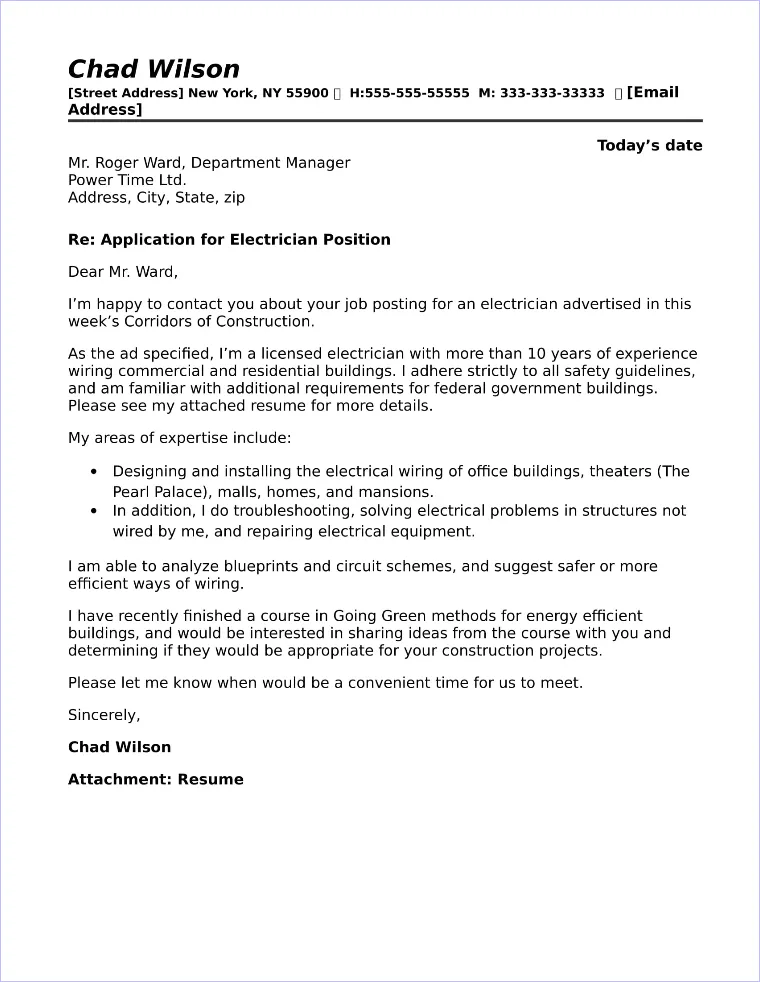
Dear [Hiring Manager Name],
I am writing to express my strong interest in the Apprentice Electrician position at [Company Name]. I am a highly motivated individual eager to begin my career as an electrician. I am currently enrolled in [Trade School/Apprenticeship Program], where I am learning the fundamentals of electrical work and gaining practical experience. I am skilled in using various hand tools, and I am eager to learn more. I am committed to safety and following all regulations. My license number is [License Number].
I am enthusiastic about the opportunity to learn from experienced professionals at [Company Name]. I am a quick learner, a dedicated worker, and I am eager to contribute to your team. I am available for an interview at your earliest convenience.
Sincerely, [Your Name]
Customizing Your Cover Letter
Always tailor your cover letter to the specific job description. This shows that you have taken the time to understand the requirements of the role and that you are genuinely interested in the position. Review the job description carefully, noting the key skills, experience, and qualifications the employer is seeking. Then, customize your cover letter to highlight those specific elements. Referencing details from the job posting will enhance your chances of being selected for an interview. (Image: A person customising a cover letter)
Tailoring to the Job Description
Carefully analyze the job description and identify the keywords and phrases used by the employer. These keywords are likely to be what the hiring manager is looking for, so incorporate them naturally into your cover letter. Highlight your skills and experiences that directly align with the job requirements. Use the same terminology as the job description to show you understand what the employer needs. This demonstrates you have the specific qualifications required to be a valuable asset to the company.
Using Keywords
Use relevant keywords throughout your cover letter. This not only helps you tailor your application to the specific job description but also increases the chances that your cover letter will be identified by applicant tracking systems (ATS). Sprinkle those keywords naturally throughout the text, making sure that you’re not just stuffing keywords in. Focus on including the most relevant and impactful ones, ensuring the cover letter remains readable and compelling. A well-placed keyword can significantly improve your chances of your application being seen and read by human eyes.
Proofreading and Editing
Before submitting your cover letter, carefully proofread it for any grammatical errors, spelling mistakes, or typos. Have a friend or family member review it as well to catch any errors you may have missed. Ensure the formatting is consistent and the language is clear and concise. A polished and professional cover letter demonstrates attention to detail and enhances your credibility. The perfect cover letter may be what sets you apart from the other candidates.
In conclusion, crafting an effective electrician cover letter is crucial to landing your dream job. By highlighting your skills and experience, customizing your letter for each job application, and following the tips outlined in this guide, you can create a compelling cover letter that captures the attention of potential employers. Always remember to proofread, proofread, and proofread again! Good luck with your job search. (Image: an electrician working)
